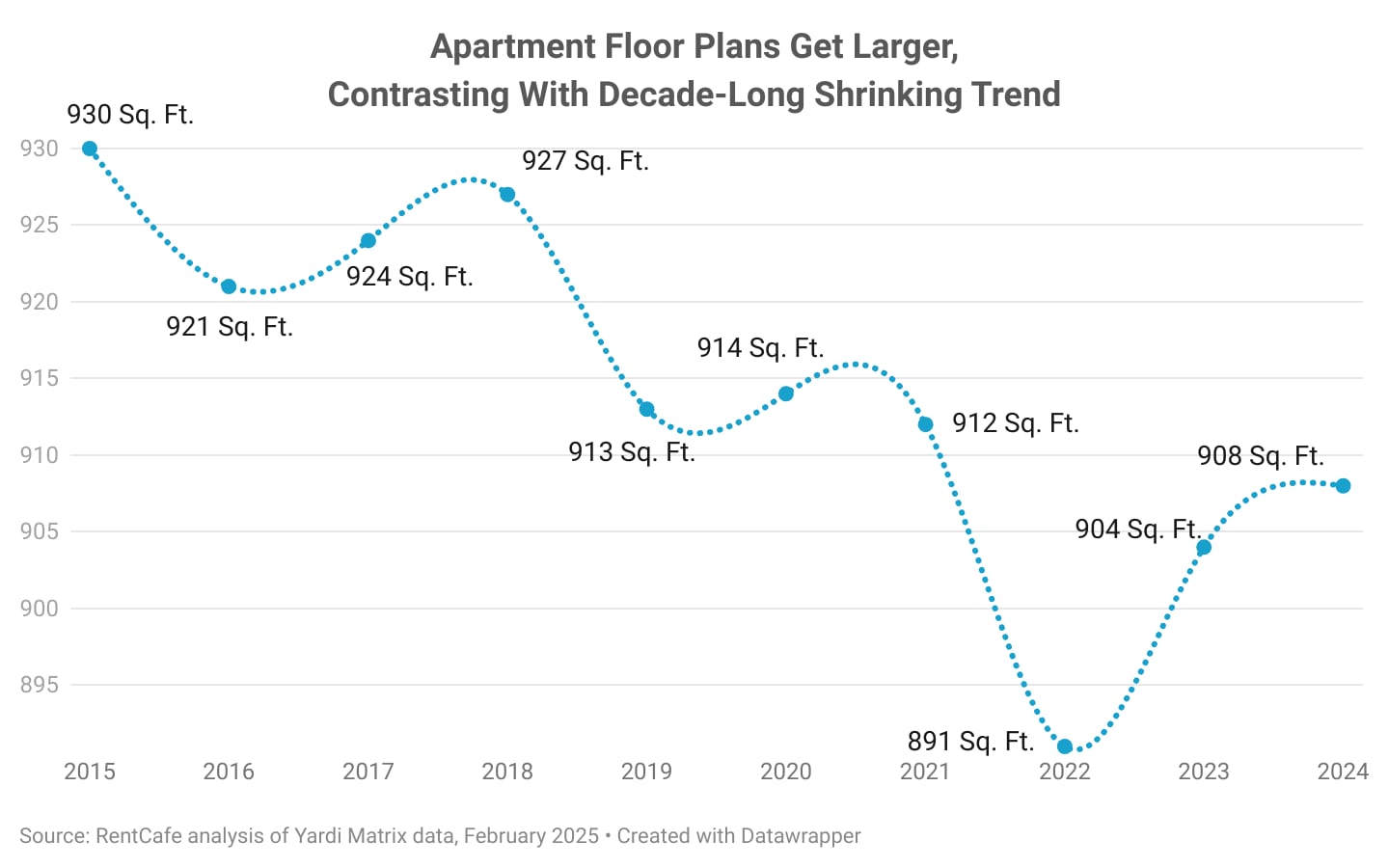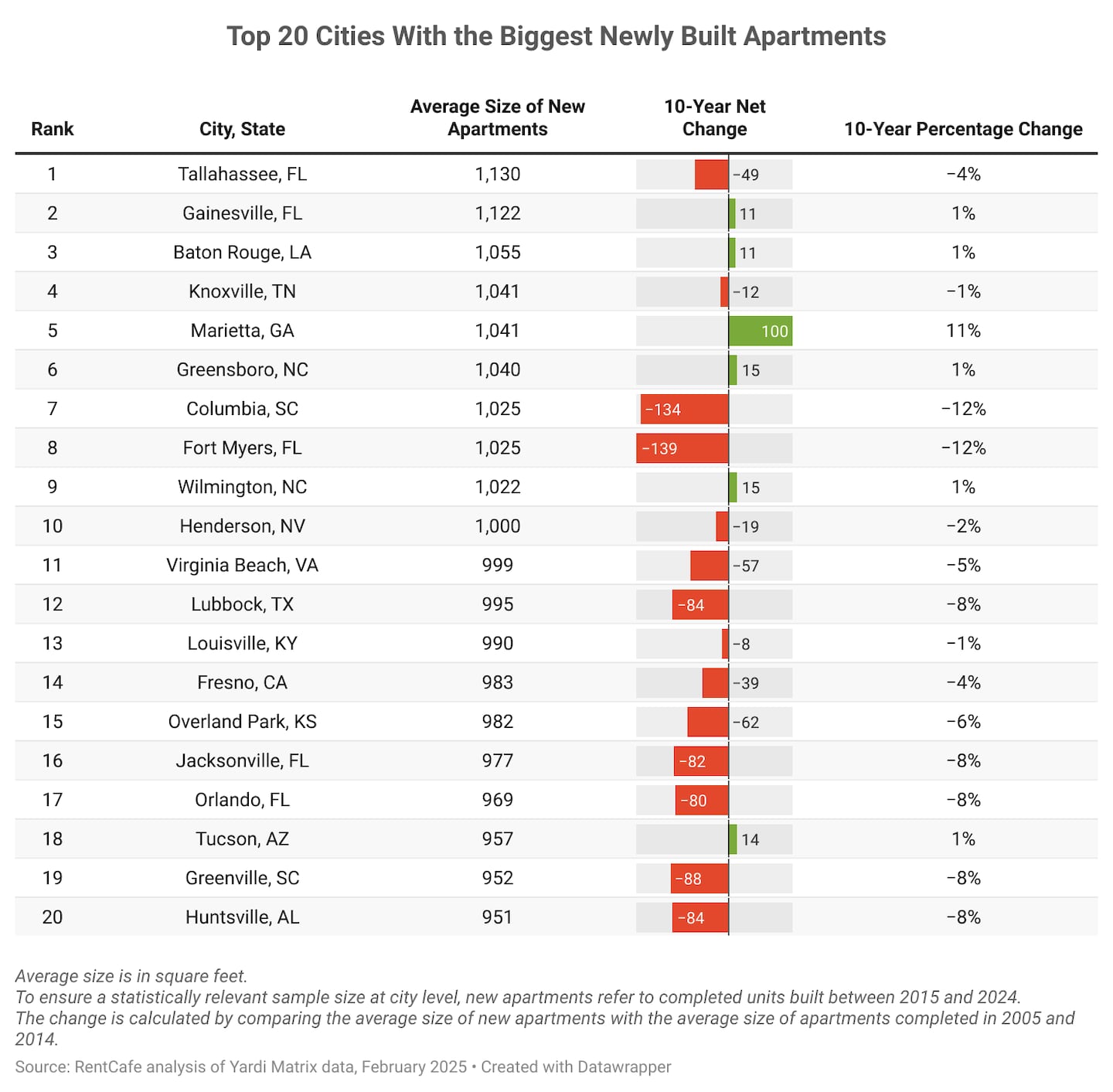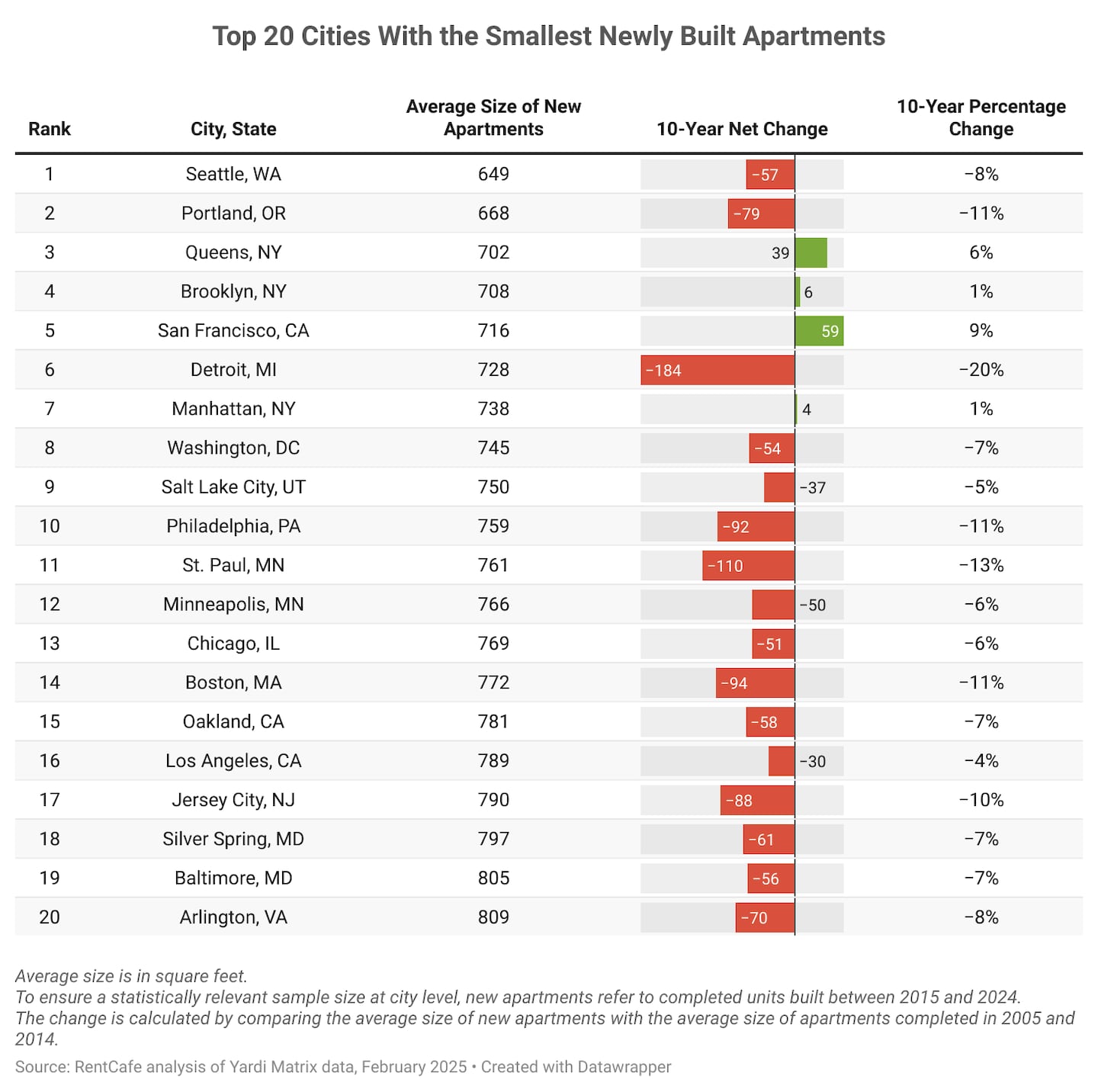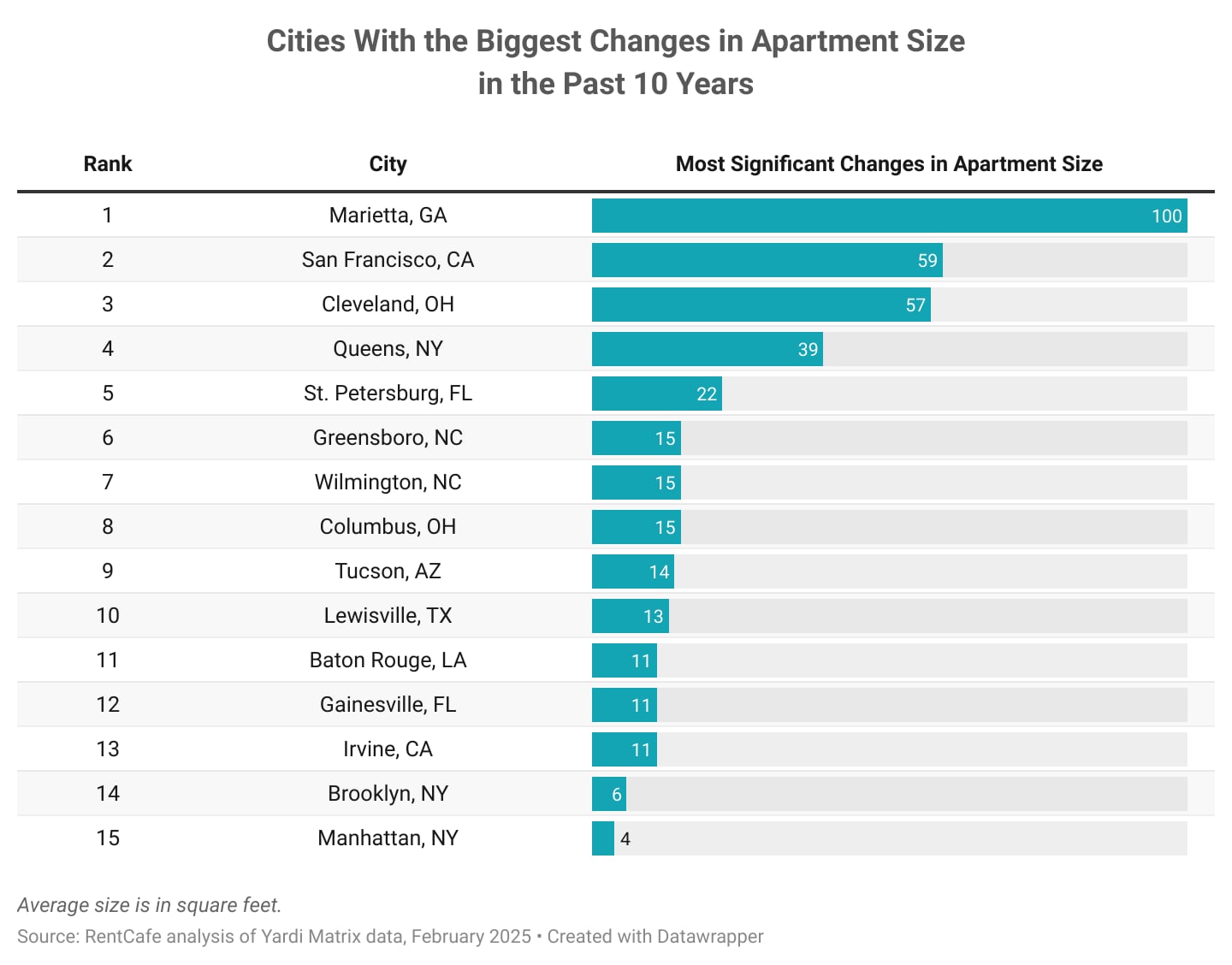Just in time for the start of the moving season, bigger apartments are making a comeback, as hybrid and remote work along with suburban living turned "more space" into a coveted amenity. RentCafe.com's annual report on apartment size found that the average size of new apartments grew in 2024, reversing a decade-long trend of more compact living space.
Highlights:
- In 2024, the average U.S. apartment size grew to 908 square feet, with most unit types offering more living space.
- Studios, one-bedroom, and two-bedroom apartments have all become larger, adding 4 to 13 square feet to their floor plans.
- Tallahassee, Florida, and Gainesville, Florida, take the top two spots when it comes to largest apartments.
- Seattle remains the city with the smallest apartment size in the U.S.
- San Francisco saw the biggest growth in apartment size among large cities, increasing by 59 square feet over the past decade, followed by New York City's borough of Queens with a 39-square-foot gain.
Renters in coastal and Sunbelt cities gained the most square footage. So, with this in mind, the RentCafe.com research team analyzed floorplans in the 100 largest U.S. renter hubs to show renters what to expect in terms of space this rental season.
RentCafe.com
Renters in some cities can expect more space
This shift in size is the result of studios and one-bedroom apartments getting more spacious over the past decade—along with two-bedroom units—while accounting for more than half (52.7%) of newly built apartments. As a result, the apartment size in the U.S. averaged 908 square feet in 2024.
Leading the pack in apartment size are Tallahassee, Florida, and Gainesville, Florida. Meanwhile, apartments in Seattle and Portland, Oregon, offer the most compact floor plans nationwide.
Conversely, several large urban areas such as San Francisco and the New York City boroughs of Queens and Brooklyn have seen increases in apartment size over the past 10 years. San Francisco, for example, added an average of 59 square feet per unit—roughly the size of a small patio—while Queens and Brooklyn units grew by 39 and 6 square feet, respectively.
That said, renters in Marietta, Georgia, saw the biggest increase in unit size. Here, the typical apartment built in the past decade is 100 square feet larger than those built before 2015. Cleveland renters are also seeing a boost in size, landing the city third among major hubs due to a notable 57-square-foot increase.
Renters in Tallahassee enjoy the most spacious rentals among 100 major U.S. cities
Southern destinations offer the most generous apartment sizes, giving renters additional breathing room. Among 100 cities surveyed, Tallahassee, Florida, tops the list, with new apartments built in the past decade averaging 1,130 square feet.
However, that means newer apartments offer 49 fewer square feet compared to those built before 2015, due to a decline in the share of two- and three-bedroom units. Even so, renters can find plenty of room in Tallahassee, making rentals here especially attractive to students and professionals who want to be close to the city's lively academic community.
RentCafe.com
Runners-up still offer plenty of space
Gainesville, Florida, follows in second place, with renters here finding that apartments built in the past 10 years now average 1,122 square feet. That is an 11-square-foot increase, which is just enough to squeeze in a bit of extra storage. This bump in size makes Gainesville an attractive option for University of Florida students and budget-conscious renters seeking comfort.
Renters looking for more Southern alternatives might also take into consideration Baton Rouge, Louisiana. Coming in third in RentCafe.com's ranking, apartments here gained an additional 11 square feet over the past decade, now reaching 1,055 square feet. Right behind is Knoxville, Tennessee, with apartments averaging 1,041 square feet. Rounding out the top five is Marietta, Georgia, where renters enjoy apartments that measure 1,041 square feet. That is an impressive 100 square feet larger than older rentals, making it perfect for setting up a small home office.
Apartment sizes are decreasing in most large cities, but not in San Francisco or New York's boroughs
While larger hubs have long been synonymous with smaller apartments, renters will find that some cities such as San Francisco, Queens, and Manhattan are beginning to buck this trend with larger new units compared to those built before 2015.
However, for many renters, finding spacious apartments is still a challenge, as most U.S. cities are seeing decreases in unit sizes, with Seattle, having the smallest newly built apartments. Here, post-2015 units average 649 square feet which is 57 square feet less than before.
Renters in Portland, Oregon, are facing a similar situation when it comes to shrinking apartment sizes. The average new rental in the City of Roses is now just 668 square feet (down 79 square feet from previous years) which makes it harder for those who need a bit more breathing room to go apartment hunting in this Pacific Northwest city.
RentCafe.com
Modest square footage gain in the smallest apartments
Comparatively, Queens and Brooklyn edged past the 700-square-foot mark, with new apartments averaging 702 and 708 square feet, respectively. These modest gains in size—39 square feet in Queens and 6 square feet in Brooklyn—reflect a shift toward adding more two- and three-bedroom options, giving renters a few extra feet to stretch their legs.
San Francisco rounds out the top five. Here, new apartments have crossed the 700-square-foot mark, with the average unit now measuring 716 square feet—a 59-square-foot jump from a decade ago. That's perfect for renters needing some extra space for a cozy reading corner or a small guest area. This growth is mainly thanks to more two-bedroom apartments being built, along with roomier studios that have added about 70 square feet each.
Meanwhile, Manhattan sits at #7 among cities with the smallest average new apartment size, coming in at 738 square feet. Still, these units are 4 square feet larger than those built before 2015, largely thanks to more spacious one- and two-bedroom options, which grew by 15 and 71 square feet, respectively. That is just enough room for a small pet or extra appliance.
Sunbelt and coastal cities' renters gain more square footage
Renters seeking roomier units might want to look at Marietta, Georgia, where new apartments are 100 square feet bigger than those from 2005–2014, representing the most significant growth nationwide. Thanks to larger one-bedroom apartments and an increase in two- and three-bedroom options, this Atlanta-area city has surpassed both Florida's Tallahassee and Gainesville in terms of unit size growth.
Next is San Francisco, where renters will find that new apartments expanded by 59 square feet. Cleveland comes third with a 57-square-foot increase, while Queens follows with a 39-square-foot increase. Rounding out the top five is St. Petersburg, Florida, where apartments are now 22 square feet larger than those built a decade before.
RentCafe.com
Developers in Detroit and other large hubs are opting for smaller apartments, leading to a decrease in unit size
In contrast, renters in places like Arlington, Texas, may find that apartments have gotten noticeably smaller. New units here are now 215 square feet less than those built a decade ago, which is more than double the size increase seen in Marietta, Georgia. The decrease in size is largely due to a shift toward more one-bedroom units and fewer larger apartments being built.
Apartment sizes are also shrinking for renters in Birmingham, Alabama, and Detroit, where living space decreased by 194 and 184 square feet, respectively. Other cities experiencing noticeable shrinking in apartment size include Memphis, Tennessee, (down 176 square feet), and Fort Myers, Florida, (down 139 square feet).
RentCafe.com
Methodology
This study was conducted by RentCafe.com, a nationwide rental search platform that helps users find apartments and houses across the U.S.
Apartment size and pricing information was provided by Yardi Matrix as of February 2025. Yardi Matrix, a sister company of RentCafe.com, specializes in apartment market intelligence for properties with 50 or more units across 177 U.S. metros. Unit types were grouped by bedroom count (studio, one-, two-, or three-bedroom) according to Yardi Matrix definitions. All figures reflect the most current data at the time of publication.
Rankings were based on the top 100 U.S. cities with the largest inventories of multifamily apartments (50+ units). Cities with fewer than 500 units completed in a given year were excluded to ensure statistical reliability.
For this report, "new apartments" are defined as those built between 2015 and 2024, allowing for more consistent trend analysis and avoiding year-to-year anomalies.
This story was produced by RentCafe.com and reviewed and distributed by Stacker.













